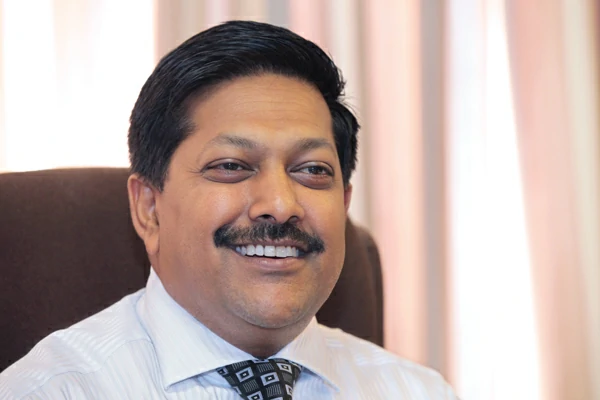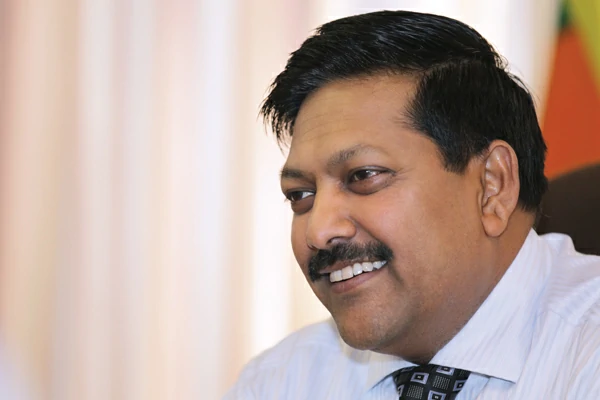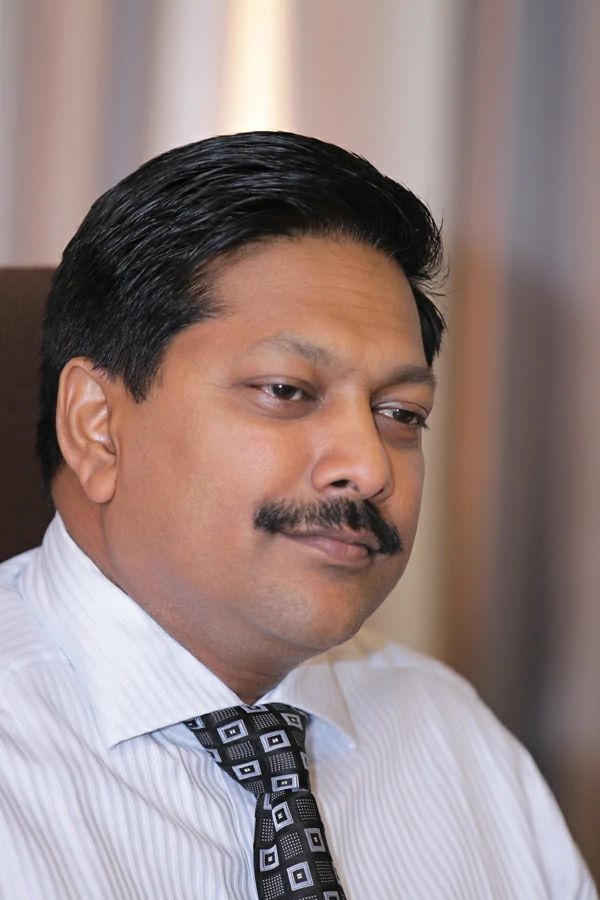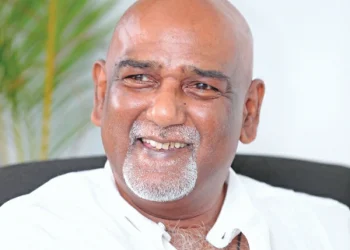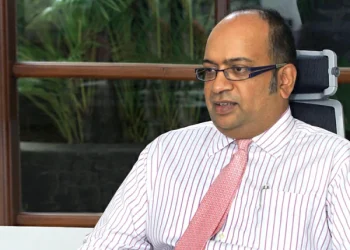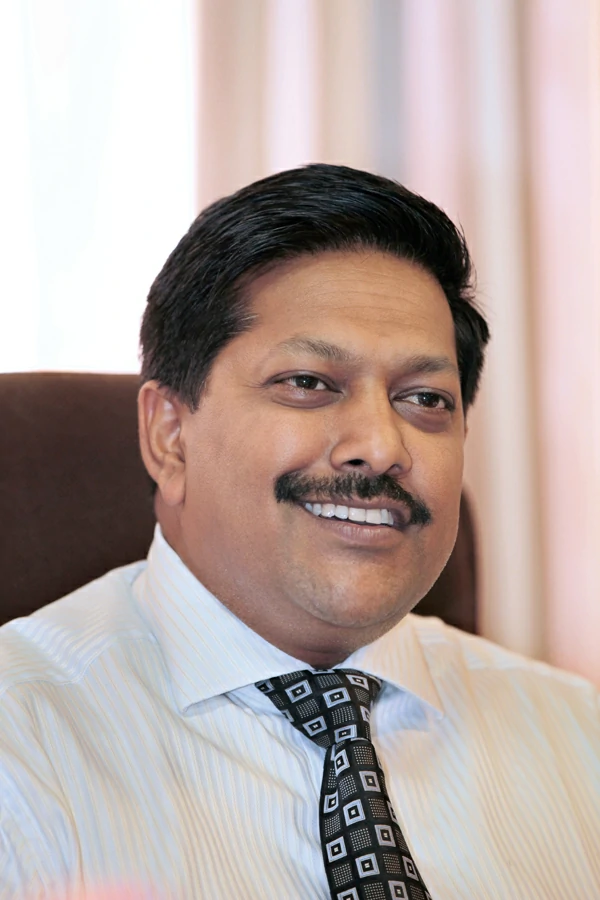
As Sri Lanka emerges as the Wonder of Asia, the country will be established as an Aviation Hub thus utilising its strategic geographical location. Prasanna Wickramasuriya, Chairman of Airport and Aviation Services (Sri Lanka) spoke with Business Today about the Hambantota International Airport, the second international airport in the country, which will be commissioned in 2012, developing domestic airports in order to ensure connectivity and revamping BIA to cater to the increasing needs as Sri Lanka moves towards becoming an Aviation Hub.
By Udeshi Amarasinghe | Photography by Menaka Aravinda and Mahesh Bandara
President Mahinda Rajapaksa envisions Sri Lanka to become an Aviation Hub. Can you tell us what plans have been made by Airport and Aviation Services (Sri Lanka) to achieve this aim?
His Excellency President Mahinda Rajapaksa even before he came into power in 2005 had this concept of Sri Lanka as an Aviation Hub. He clearly spelt this out in his manifesto – the Mahinda Chintana. Six years have passed and during this very short period Airport and Aviation has worked towards achieving this aim. Two very important aspects that we need to consider are; we cannot work in isolation and the required infrastructure needs to be in place. This is the first time since Independence that a leader of this country has recognised the importance of having a second international airport in the country and has made it happen. Our technical team conducted a comprehensive study and a suitable location was identified in Mattala in Hambantota where work is ongoing at the moment.
A number of reasons were considered when deciding upon a second international airport in the country. There was a request from international airlines flying into the country as they have to absorb a heavy cost as for example, a flight coming from London to Colombo, has to carry an additional fuel load in case of an emergency in Colombo, they will have to divert the plane to another destination, which incurs an additional cost. This cost is ultimately borne by the passenger. Furthermore many of the eastern air routes are over Mattala therefore it will be much easier for airlines to plan their flights to Mattala, which will be much faster. In and around Hambantota is a tourist destination where there are many attractions. It is a very central location as it takes only about three to four hours to major tourist destinations. Additionally, His Excellency the President wanted the Colombo based economy to go to the villages and as such besides the airport, other massive projects have been implemented to develop Hambantota and the surrounding areas.
We are now marching forward after the end of the 30 year-long conflict. We are inviting other airlines and working very closely with neighbouring airports to increase air traffic to Colombo as well as to Hambantota. Geographically, Sri Lanka is located in an ideal location for an Aviation Hub.
His Excellency The President Wanted The Colombo Based Economy To Go To The Villages And As Such Besides The Airport, Other Massive Projects Have Been Implemented.
Currently Bandaranaike International Airport (BIA) is the only international airport in the country. We have seen massive developments in the airport during the past few years. Can you tell us what improvements have been made?
The current passenger capacity at BIA has reached six million passengers per annum. We will need to increase the passenger capacity if we are to become an Aviation Hub. We need to provide more facilities and comforts to passengers to encourage them to fly to Colombo. We are heading towards that goal and for example by the end of 2010, we recorded more than five million passengers. We are planning to construct another terminal so that this capacity can be doubled by 2015.
In order to facilitate the passengers, they must be comfortable to fly either into the country or to transit via Colombo. Therefore we are working on those lines now. To name but a few during the past two years we have constructed a transit hotel inside the airport. It is a 24-room transit hotel with a spa and other facilities of a luxury hotel. New lounges have been introduced with all the required comforts to passengers where it was not there earlier. We have also introduced a VIP lounge based on the concept of the Silk Route, especially for business passengers, actually any passenger can visit our website and make reservations for this facility. Our staff members will receive the passenger on the aircraft, take them through the special immigration counter to the Silk Route lounge. While they relax our staff will obtain custom clearance for their luggage. Internet, facsimile facilities and refreshments are provided and the lounge is located close to the entrance for easy exit.
In Order To Become An Aviation Hub, Connectivity Both Locally And Internationally Is Of Great Importance. Therefore We Have To Develop Our Domestic Facilities As Well.
At the end of 2010, approximately 657,000 tourists arrived in Sri Lanka; therefore we are working very closely with the Sri Lanka Tourist Board to provide facilities for the tourists. We have introduced the airport express train, which runs from BIA to Colombo Secretariat Station close to Hilton Colombo. In such ways we are improving our services with the demand. A play area has been constructed for children and we are also planning on building an entertainment area as well.
Our vision is to be the friendliest and the most efficient aviation hub in the Asian region. In order to achieve this aim we have trained our staff, especially the frontline staff and made them understand that the initial point of contact is very important. Frontline staff members are being trained to speak other foreign languages such as French, German, Hindi, Chinese and other such languages. We have set our benchmark as Changi airport, Singapore and we want to ensure that the passengers comfort comes first.
We are currently expanding the transit area, which will be ready in three months time. We will be adding a further 1,000 square feet to that area. Another project in the pipeline is that we are hoping to build a shopping mall because an airport cannot work in isolation. We want to make BIA, the Katunayake Airport City. We will be bringing more brands, both local and international to the Airport as well. We are hoping to complete this project at least by 2012 and the airport will be linked to the shopping mall by an overhead bridge. The shopping mall will showcase the finest of our apparel industry as we produce the best garments. This will give tourists the opportunity to purchase these items, when certain segments especially the Indian market come to Sri Lanka for shopping.
A transit hotel is a requirement, because now as you know with the influx of tourists, our expansion towards becoming an Aviation Hub and connectivity with Colombo, hotel accommodation is a prime requirement. The hotel will consist of 300 rooms, which will fulfil the need as too many transit hotels in the vicinity will not be viable.
The Kalpitiya tourist triangle is being developed and from the airport to Kalpitiya is about an hours drive. Therefore this hotel will provide the required facilities to tourists. And also because of the proximity to Colombo this project is extremely viable.
The hotel will have all the facilities of a star class hotel. Even at the current transit hotel we have a conference room because of the demand for such facilities as many meetings are held among regional corporates. The new hotel while including conference and convention facilities will also have entertainment centres as well.
Additionally, there has been a demand from airline crews for accommodation closer to the airport as it is difficult to travel to Colombo due to time limitations. Therefore the benefits from this hotel are multifaceted.
Can you tell us the thinking behind the new domestic terminal?
In order to become an Aviation Hub, connectivity both locally and internationally is of great importance. Therefore we have to develop our domestic facilities as well. For example, a passenger flying from London to Jaffna, can disembark in Colombo and take a domestic flight from here to Palali, which reduces the time of travel. That is the thinking behind having a domestic terminal. The terminal and building will be ready by the end of this year.
Now, the company has identified the need for doubling the handling capacity at Bandaranaike International Airport within the next five years and construction work necessary for such capacity enhancements are planned. Can you elaborate on this?
We have to expand the capacity in Colombo. It is true that Hambantota International Airport (HIA) will be commissioned by 2012, in stage one HIA will be able to cater to one million passengers. Similar to BIA, HIA will be operated as 60 percent cargo and 40 percent passengers. Therefore for Sri Lanka to become an Aviation Hub, Colombo has to be expanded further.
As I mentioned previously we want to double the capacity by 2015, in order to do that we have to start the project this year. Initial negotiations are ongoing at the moment. It will be another state of the art terminal and will be in two levels. The Katunayake – Colombo expressway, which is under construction, will have an exit to the terminal. Additionally we are constructing a multi-storey car park. The entire complex will have an extent of 96,000 square metres.
Access to the airport is very difficult, however the Colombo-Katunayake Highway is in progress. What other mechanisms have been put in place to reduce congestion to BIA?
Yes that is one of the reasons that we introduced the Airport Express train. The airport transfer is from Katunayake to the Secretariat Station in central Colombo. The passenger capacity is 90, but we are hoping to increase the number of trains. Furthermore, the Katunayake Expressway will be extended to Ratmalana as this airport will be developed as a city airport. The thinking is that since the number of corporate jets arriving in Sri Lanka is increasing, these can be diverted to Ratmalana airport. And since there is an existing railway line this can be utilised for this purpose.
We are speaking to freight forwarders on the possibility of utilising this railway service and they are happy to do so. This will reduce the traffic congestion. And also Helitours is currently providing helicopter flights, then we have the taxi services as well.
We intend to extend this railway track by another 200 metres towards the main terminal. We have many plans in relation to the Airport Express, and we hope to extend this to Hikkaduwa and Kandy.
The access road to BIA was redone within 28 days due to the efforts of Minister Basil Rajapaksa and as such now the airport can be reached easily.
Hambantota International Airport (HIA) is one of the largest projects under the supervision of Airport and Aviation. Stage I of the airport is to be completed in 2012. Can you tell us the progress so far?
HIA is being constructed in two stages. The estimated project cost is USD 209 million and the total land area is 2000 hectares. Stage one will take place on 800 hectares initially and the runway will be constructed during this stage. 60 percent of the cost goes to the runway. The runway at HIA will be able to facilitate A380 aircraft as the runway length is 3500 metres, and width is 75 metres. At the moment the runway at BIA has a width of 60 metres, as such an A380 cannot land here.
Passenger capacity during the initial stage will be one million, which will entail 40 percent of the function of the airport and cargo capacity will be approximately 45,000 metric tonnes, which is equivalent to 60 percent of the capacity. The project is progressing at a very good speed. We are about three months ahead of schedule and we hope to commission the airport by end 2012.
An airport cannot exist in isolation therefore, a tax free industrial zone will be established as well as other aviation related industries such as aircraft painting, repair shops, aircraft maintenance areas and flying academies and also, of course, hotels and related infrastructure in the leisure sector will be encouraged to come to Hambantota.
Then, the Magam Ruhunupura Port, HIA and the international cricket ground will be linked by a railway system. Currently, the development of the road network in Hambantota is happening at a rapid pace. It is not only Hambantota that will benefit but also the bordering districts. There will be direct and indirect job opportunities created. The airport will create opportunities in agriculture; the farmers of the area can grow fruits and vegetables which they will be able to export, then fishermen can export their fish. At the moment perishable cargo/goods are very important and there is a large Middle Eastern market and huge demand for this segment. Therefore, minimum-handling time is of utmost importance.
Then of course the hotel industry and transportation sector will be developed as I mentioned earlier, many airport related activities will be generated. HIA will benefit the tourism industry due to its close proximity to the East coast and Uva Province, therefore it is not only Hambantota but the entire country will benefit from the airport.
The Hambantota International Airport will be an entire aviation complex with aircraft Maintenance, Repair and Overhaul (MRO) facilities, aircraft painting and flying schools as well as connected to trades such as hospitality, tourism, freight forwarding and courier services. Can you tell us whether any investments have come through for these sectors?
Right now, we are having discussions with potential investors. We would like logistics and courier companies such as Aramex, FedEx, DHL and UPS to come to Hambantota. For one thing it will be an essential tool to market the Hambantota airport as they have global networks and in our journey towards becoming an Aviation Hub our linkages with these global services will be essential.
At The End Of 2010, We Recorded Three Billion Rupees In Net Profits, Which Is The First Time In History Of Airport And Aviation.
There is a demand for airlines who are currently flying to Colombo to increase their frequencies. The additional frequencies can be directed to Hambantota and many airlines are willing to do so. Then there will be charter flights, which can be directed to HIA. In such ways there is a huge potential. 37 percent of those who are employed abroad are from the southern province, especially those working in the Middle East. In future, they will not have to travel to Colombo, they will be able to fly out of Hambantota.
The Government of Sri Lanka wants Hambtantota to become a sea air transshipment hub. Due to the geographical location of Sri Lanka this would be ideal. Currently we are tapping a very small portion of the cargo business and cargo is the largest business in the aviation industry. In order to do so we need to have an airport and port in close proximity. In Hambantota we have that; the port and the airport are only about 20 miles apart. We will offer very good rates that will be competitive in the region.
What plans have been made for domestic airports?
As I mentioned, for Sri Lanka to become an Aviation Hub connectivity both internationally and locally is of utmost importance. Now since there is an increase in tourist arrivals we are looking at expanding our domestic airports. Currently only the Sri Lanka Air Force is functioning at these locations. Therefore Airport and Aviation will look at introducing commercial flights. Currently we are looking at Palali, Trincomalee, Anuradhapura, Ratmalana, Ampara and also Sigiriya to expand our domestic airport capacity.
We have a total of 13 domestic airports. Therefore, we will identify commercially viable airports where there are many tourist attractions, and during the initial stages focus on those and later indentify further domestic airports to develop.
Airport and Aviation is being transformed into a market oriented public company capable of withstanding competition and benefits from competitive advantage. What are your thoughts on this?
I am very proud to say that we have a brilliant workforce at Airport and Aviation, from minor employees to engineers. I am very proud of that. At the end of 2010, we recorded three billion rupees in net profits, which is the first time in history of Airport and Aviation. We achieved this while paying our loan installments and working on massive scale projects. Therefore we are very proud of this achievement. In future we will diversify our business and venture into the airport hotel project. I hope to achieve double profits by end of 2011.
We Are Also Aiming To Achieve The Mahinda Chintana Vision, Where Profits Are Not The Only Aspect But Also Expanding Infrastructure And Passenger Facilities.
We are also aiming to achieve the Mahinda Chintana vision, where profits are not the only aspect but also expanding infrastructure and passenger facilities. But we are managing our finances well. We also had to think out of the box and an example of that was introducing the Airport Express and also the concept of building an apparel mall. With the support of the Minister of Economic Development Basil Rajapaksa and Sri Lanka Tourism we are hoping to launch another project for transit passengers where they can visit tourist attractions in close proximity to the BIA in the Gampaha district.
SriLankan Airlines, Sri Lanka Tourism and Airport and Aviation are working closely together to implement various projects.
Can you tell us about the security level at the BIA?
Security of the BIA is very good. I wish to express my gratitude to His Excellency the President and Secretary of Defence for providing the leadership that saw an end to the conflict and eliminated terrorism in our country. Though the war is over we have not neglected the security of the airport. As any airport in the world we have ensured that the security at BIA is at the best.
You come from a diverse background and have a plethora of experiences. Can you tell us about yourself?
I have been facing challenges since the age of 18. I joined the Army when I was 18 and served for 22 years. The experiences that I garnered while I was in the Military has enabled me to overcome many challenges. Furthermore I observe how others face challenges such as His Excellency, Secretary of Defence and the others. My mother was a great strength to me. She became a Buddhist nun during the latter part of her life. Facing challenges is a passion of mine as well.
I am very proud to say I am one of the most decorated retired officers who are living in Sri Lanka. I have taken part in many battles as well as humanitarian operations. After my retirement, I migrated to the US and to market tea to coffee drinking people. I joined my brother, Jaliya Wickramasuriya who is now the Ambassador to the US. Then with the escalation of the conflict I was asked to return to Sri Lanka and I worked very closely with Secretary of Defence contributing my knowledge and experience. I am very proud that I was able to make a contribution to the end of the conflict.
My wife, Kumudini and I have three sons. Kumudini is a primary school teacher in the US. My eldest son Pravishka, is 21 years old, and he is completing his degree this year in Finance, my second son Mathishka, is in high school and my youngest, Ayeshka will be starting high school. We are a very happy family. I am very proud of my children, I miss them but whenever I have time I visit them. My sons too want to come back to Sri Lanka and work for the country.
Going forward, what are your thoughts?
We will work towards making His Excellency the President’s vision a reality. We will contribute in our capacity towards achieving the goals set out in the Mahinda Chintana vision, so that Sri Lanka will emerge as the Wonder of Asia.
